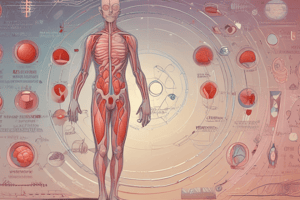Podcast
Questions and Answers
What is the primary characteristic that distinguishes type 1 diabetes from type 2 diabetes?
What is the primary characteristic that distinguishes type 1 diabetes from type 2 diabetes?
- Impaired glucose uptake
- Insulin resistance
- Impaired insulin secretion
- Absolute insulin deficiency (correct)
Which of the following is NOT a common symptom of diabetes?
Which of the following is NOT a common symptom of diabetes?
- Headache (correct)
- Polyphagia
- Polyuria
- Fatigue
What is the primary function of glucagon in normal glucose metabolism?
What is the primary function of glucagon in normal glucose metabolism?
- Stimulates glucose uptake in cells
- Stimulates glucose release from storage (correct)
- Inhibits glucose release from storage
- Inhibits glucose uptake in peripheral tissues
What is the diagnostic criterion for diabetes based on hemoglobin A1c (HbA1c) levels?
What is the diagnostic criterion for diabetes based on hemoglobin A1c (HbA1c) levels?
What is the primary goal of lifestyle modifications in diabetes management?
What is the primary goal of lifestyle modifications in diabetes management?
Which of the following is a microvascular complication of diabetes?
Which of the following is a microvascular complication of diabetes?
What is the primary purpose of screening for diabetic ketoacidosis (DKA) in type 1 diabetes?
What is the primary purpose of screening for diabetic ketoacidosis (DKA) in type 1 diabetes?
Which of the following is a risk factor for developing type 2 diabetes?
Which of the following is a risk factor for developing type 2 diabetes?
Flashcards are hidden until you start studying
Study Notes
Definition and Classification
- Diabetes mellitus is a group of metabolic disorders characterized by high blood sugar levels (hyperglycemia) due to defects in insulin secretion, insulin action, or both.
- Classified into two main types:
- Type 1 diabetes (T1D): beta-cell destruction, usually leading to absolute insulin deficiency
- Type 2 diabetes (T2D): insulin resistance, impaired insulin secretion, and increased glucose production
Pathophysiology
- Normal glucose metabolism:
- Insulin stimulates glucose uptake in cells
- Glucagon stimulates glucose release from storage
- In diabetes:
- Insulin deficiency or resistance leads to hyperglycemia
- Increased glucose production in the liver
- Impaired glucose uptake in peripheral tissues
Causes and Risk Factors
- Type 1 diabetes:
- Genetic predisposition
- Autoimmune destruction of beta-cells
- Type 2 diabetes:
- Obesity and physical inactivity
- Insulin resistance
- Family history
- Age (>45 years)
- Ethnicity (African American, Hispanic, American Indian)
Symptoms
- Common symptoms:
- Polyuria (excessive urination)
- Polydipsia (excessive thirst)
- Polyphagia (excessive hunger)
- Fatigue
- Blurred vision
- Slow healing of cuts and wounds
- May be asymptomatic in early stages
Diagnosis
- Diagnostic criteria:
- Fasting plasma glucose ≥ 126 mg/dL
- 2-hour plasma glucose ≥ 200 mg/dL during an oral glucose tolerance test
- Hemoglobin A1c (HbA1c) ≥ 6.5%
- Additional tests:
- Urine test for ketones (in T1D)
- Autoantibody tests (in T1D)
Complications
- Acute:
- Diabetic ketoacidosis (DKA)
- Hypoglycemia
- Chronic:
- Microvascular complications:
- Retinopathy
- Nephropathy
- Neuropathy
- Macrovascular complications:
- Cardiovascular disease
- Peripheral artery disease
- Stroke
- Microvascular complications:
Management
- Lifestyle modifications:
- Healthy diet
- Regular physical activity
- Weight loss (if overweight)
- Pharmacological interventions:
- Insulin therapy (in T1D and some T2D cases)
- Oral antidiabetic agents (in T2D)
- Injectable medications (in T2D)
- Monitoring and surveillance:
- Regular blood glucose monitoring
- HbA1c monitoring
- Screening for complications
Definition and Classification
- Diabetes mellitus is a group of metabolic disorders characterized by high blood sugar levels (hyperglycemia) due to defects in insulin secretion, insulin action, or both.
- Classified into two main types: Type 1 diabetes (T1D) and Type 2 diabetes (T2D).
Pathophysiology
- In normal glucose metabolism, insulin stimulates glucose uptake in cells, and glucagon stimulates glucose release from storage.
- In diabetes, insulin deficiency or resistance leads to hyperglycemia, increased glucose production in the liver, and impaired glucose uptake in peripheral tissues.
Causes and Risk Factors
- Type 1 diabetes is caused by genetic predisposition and autoimmune destruction of beta-cells.
- Type 2 diabetes is caused by obesity and physical inactivity, insulin resistance, family history, age (>45 years), and ethnicity (African American, Hispanic, American Indian).
Symptoms
- Common symptoms of diabetes include polyuria (excessive urination), polydipsia (excessive thirst), polyphagia (excessive hunger), fatigue, blurred vision, and slow healing of cuts and wounds.
- Diabetes may be asymptomatic in early stages.
Diagnosis
- Diagnostic criteria for diabetes include fasting plasma glucose ≥ 126 mg/dL, 2-hour plasma glucose ≥ 200 mg/dL during an oral glucose tolerance test, and hemoglobin A1c (HbA1c) ≥ 6.5%.
- Additional tests for diabetes diagnosis include urine test for ketones (in T1D) and autoantibody tests (in T1D).
Complications
- Acute complications of diabetes include diabetic ketoacidosis (DKA) and hypoglycemia.
- Chronic complications of diabetes include microvascular complications (retinopathy, nephropathy, neuropathy) and macrovascular complications (cardiovascular disease, peripheral artery disease, stroke).
Management
- Lifestyle modifications for diabetes management include healthy diet, regular physical activity, and weight loss (if overweight).
- Pharmacological interventions for diabetes management include insulin therapy (in T1D and some T2D cases), oral antidiabetic agents (in T2D), and injectable medications (in T2D).
- Monitoring and surveillance for diabetes management include regular blood glucose monitoring, HbA1c monitoring, and screening for complications.
Studying That Suits You
Use AI to generate personalized quizzes and flashcards to suit your learning preferences.




